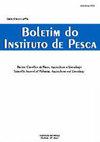Integrated multitrophic aquaculture in ponds using substrate for periphyton as natural source of food
IF 0.6
4区 农林科学
Q4 FISHERIES
引用次数: 0
Abstract
As a productive and sustainable alternative to fish farmers, the present study aims to evaluate the use of substrate for periphyton growth in an Integrated Multitrophic Aquaculture (IMTA) with complementary species. The studied species were: Nile tilapia (Oreochromis niloticus), grass carp (Ctenopharyngodon idella) and curimbatá (Prochilodus lineatus). The experiment had four treatments with three replicates that evaluated the IMTAs: [T100] Cb:C – tilapia inside hapas fed on recommended feed, with grass carp and curimbatás outside the hapas making use of natural food; [T50] Cb:C – the same species distribution with tilapia fed 50 % of the daily amount of commercial diet. Cb:C 100 and Cb:C 50 – grass carp and curimbatás fed on recommended feed at two feeding rates (100% and 50%) with substrate for periphyton growth in the feeding restriction treatment. In phase II, tilapias were included in all the treatments as a complementary species. Growth performance of fish and physical-chemical parameters of water were evaluated. In the proposed models, the species were efficient in utilizing the feed and in nutrient cycling, achieving productivity of 6 t/ha in the system without water renewal. Inserting secondary and complementary species reduced the feed conversion ratio (FCR) to values of 0.95 in systems under feed restriction and 1.28 in the groups that received 100% of commercial feed. Considering the reduction of the FCR and the high productivity, farmers can diversify their products in the same area without increasing inputs.利用围岩底质作为天然食物来源的池塘综合多营养水产养殖
作为一种高效和可持续的替代养鱼户,本研究旨在评估具有互补物种的综合多营养水产养殖(IMTA)中基质对周围植物生长的利用。研究物种有:尼罗罗非鱼(Oreochromis niloticus)、草鱼(Ctenopharyngodon idella)和梭子鱼 (Prochilodus lineatus)。试验共设4个处理,3个重复,分别对imta进行评价:[T100] Cb:C -罗非鱼在试验区内饲喂推荐饲料,草鱼和curimbatás在试验区外饲喂天然饲料;[T50] Cb:C -与罗非鱼日投喂量50%的商业饲料种类分布相同。Cb: c100和Cb: c50 -草鱼和curimbatás在限饲条件下,以推荐饲料(100%和50%)为饲粮,外加生长基质。在第二阶段,罗非鱼作为补充鱼种被纳入所有的处理。对鱼的生长性能和水的理化参数进行了评价。在所提出的模型中,该物种对饲料的利用和养分循环都很有效,在没有水分更新的情况下,该系统的生产力达到了6 t/ha。添加次级和补种使饲料系数(FCR)在限饲组降至0.95,在100%饲喂商品饲料组降至1.28。考虑到FCR的降低和生产力的提高,农民可以在不增加投入的情况下在同一地区实现产品多样化。
本文章由计算机程序翻译,如有差异,请以英文原文为准。
求助全文
约1分钟内获得全文
求助全文
来源期刊

Boletim do Instituto de Pesca
FISHERIES-ZOOLOGY
CiteScore
0.80
自引率
0.00%
发文量
24
审稿时长
>12 weeks
期刊介绍:
To publish original articles of research and short communications in the following áreas: Fisheries, Aquaculture, Zootechnology, Limnology, Oceanography, Biology and Pathology of aquatic organisms. The publication depends on the approval of the Editorial Board, based on the peer review.
 求助内容:
求助内容: 应助结果提醒方式:
应助结果提醒方式:


